| JUNE 2022 |
|
5 shows in T˘ky˘ (Kabukiza, National Theatre, Asakusa K˘kaid˘, National Theatre), 2 in Fukuoka (Hakataza) and 3 tours (Sh˘chiku Kabuki Dance Tour, Ibuki Tour, Tsuru-no-Ko-Kai)!
|
| Kabukiza (T˘ky˘) |  |
| Dates | 2 ~ 27 June 2022 Rokugatsu ďkabuki June Grand Kabuki |
| 1st program |
Sugawara Denju Tenarai Kagami (Kurumabiki) Cho Hakkai |
| 2nd program |
Nobuyasu |
| 3rd program |
Furu Amerika-ni Sode-ha Nurasaji |
| Casting |
|
| Comments |
The 3 programs for the June Grand Kabuki at the Kabukiza. Due to health-related reason, Living National Treasure Kataoka Nizaemon could not perform in June 2022 at the Kabukiza. The star was expected to play the role of Yosabur˘ in the drama "Yowa Nasake Ukina no Yokogushi" with Living National Treasure Band˘ Tamasabur˘ in the role of Otomi. He was not replaced and, therefore, there has been a drama change for the 3rd progam of the June Grand Kabuki. Instead of "Kirare Yosa", "Furu Amerika-ni Sode-ha Nurasaji" is staged under the direction of Living National Treasure Band˘ Tamasabur˘.
|
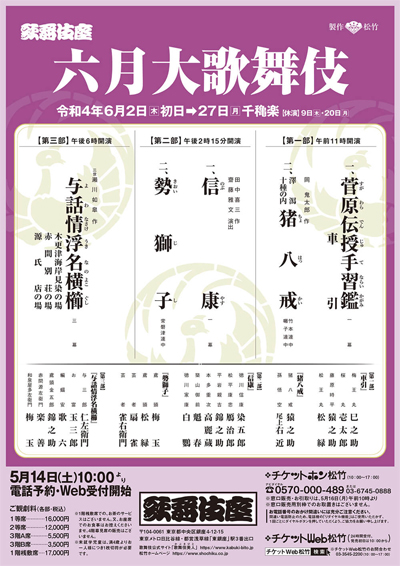 |
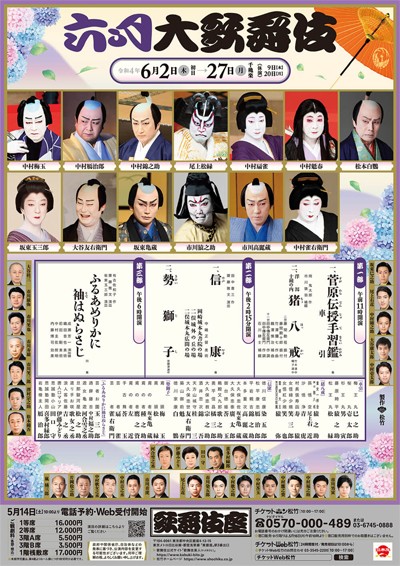 |
|
|||
| Dates | 3 ~ 23 June 2022 Rokugatsu Hakataza ďkabuki June Hakataza Grand Kabuki |
||
| MatinÚe | |||
| Evening | |||
| Casting |
Living National Treasure Onoe Kikugor˘, Nakamura Tokiz˘, Nakamura Shikan, Onoe Kikunosuke, Band˘ Hikosabur˘, Nakamura Baishi, Kawarasaki Gonjűr˘, Nakamura Yonekichi, Nakamura Mantar˘, Ichimura Kitsutar˘ |
||
| Comments |
The traditional two programs for the June Grand Kabuki at the Hakataza.
|
||
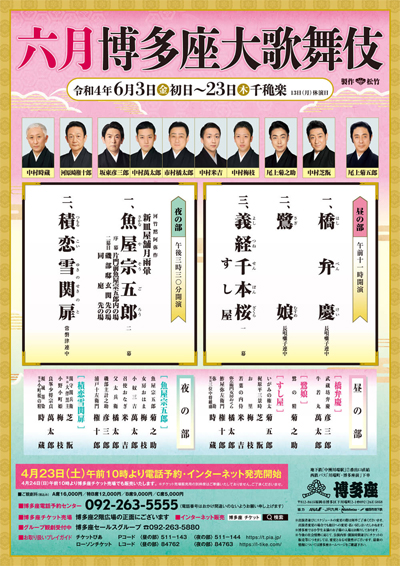 |
| National Theatre (T˘ky˘) |
| Dates | 2 ~ 21 June 2022 Rokugatsu Kabuki Kansh˘ Ky˘shitsu June Kabuki Appreciation Class |
| Program |
Kabuki no Mikata Hikosan Gongen Chikai no Sukedachi
|
| Casting |
Nakamura Matagor˘, Kataoka Takatar˘, Nakamura Kash˘, Nakamura Matsue, Kamimura Kichiya, Nakamura Tamatar˘, Ogawa S˘ma |
| Comments |
Educational program at the National Theatre called Kabuki Kansh˘ Ky˘shitu ('Kabuki Appreciation Class'). This is a very interesting formula for the beginners because there is lively presentation on stage (Kabuki no Mikata) of Kabuki or some aspects of the art like music, stage tricks or fighting scenes. It is followed by "Sugisaka" and "Keya-mura".
|
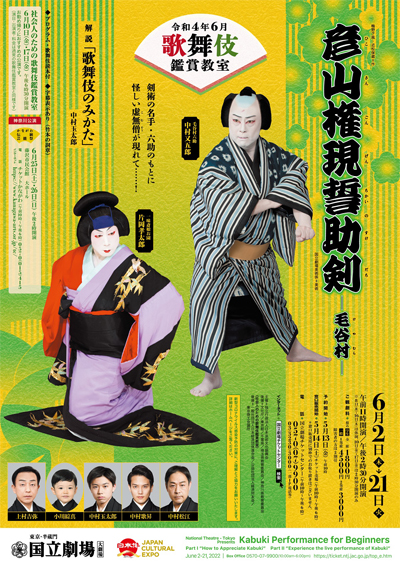 |
| Sh˘chiku Kabuki Dance Tour | |
| Dates | 30 June ~ 31 July 2022 Sh˘chiku Kabuki Buy˘ K˘en Sh˘chiku Dance Performances |
| Program |
Goaisatsu |
| Casting |
Nakamura Shikan, Nakamura Matsue, Nakamura Hashinosuke, Nakamura Fukunosuke, Nakamura Utanosuke |
| Comments |
The Summer Buy˘ Tour of Nakamura Shikan and his three sons.
|
 |
| Ibuki Tour | |
| Dates | 1 ~ 26 June 2022 Ibuki Tokubetsu K˘en Ibuki Special Performances |
| Program | |
| Casting | |
| Comments |
A special tour with two popular young actors. Ibuki means 'breath'.
|
 |
|
|||
| Dates | 5 June 2022 Kakumeikai |
||
| Program |
T˘ku K˘nÔ |
||
| Casting |
Nakamura Tsurumatsu, Nakamura Kankur˘, Nakamura Shichinosuke, Nakamura Toranosuke, Kamimura Kichitar˘ |
||
| Comments |
1st edition of the Kakumeikai, a gala program which stars Nakamura Tsurumatsu.
|
||
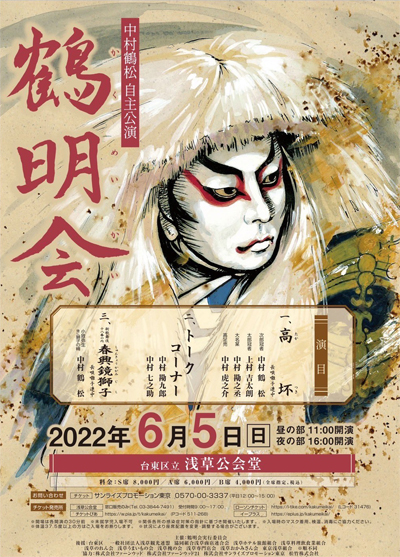 |
| Tsuru-no-Ko-Kai Tour | |
| Dates | 8 ~ 12 June 2022 Tsuru-no-Ko-Kai |
| Program |
Fukiyose Sugoroku Kabuki-juku Maizuru Sanbas˘ |
| Casting |
Nakamura Tsurumatsu, Nakamura Ich˘, Nakamura Nakaji, Nakamura Nakasuke, Nakamura Nakaya, Nakamura Nakashir˘ |
| Comments |
1st edition of the Tsuru-no-Kokai, a special tour in 5 old traditional wooden theaters in Gifu Prefecture: the Kashimo Meijiza, the Miyamoriza, the Gom˘za, the Azumaza and the Aioiza. |
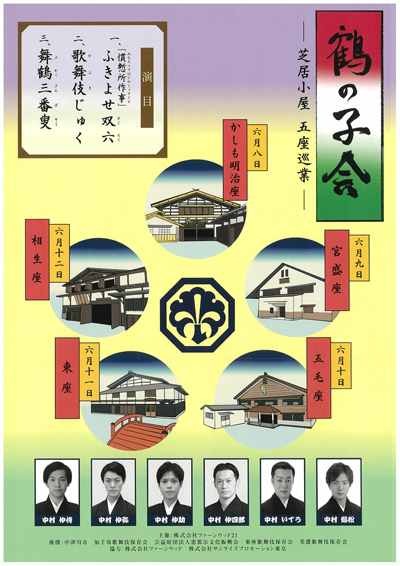 |
| National Theatre (T˘ky˘) |
| Dates | 22 June 2022 Nakamura Ky˘z˘ Buy˘ no Yűbe Evening for Dance by Nakamura Ky˘z˘ |
| Program | |
| Casting |
Nakamura Ky˘z˘, Nakamura Tsurumatsu, Nakamura Ich˘ |
| Comments |
7th edition of the Buy˘ gala Nakamura Ky˘z˘ Buy˘ no Yűbe, dedicated this time to the legend of D˘j˘ji.
|
 |
|
|
| Contact | Main | Top | Updates | Actors | Plays | Playwrights | Programs | Links | FAQ | Glossary | Chronology | Illustrations | Prints | Characters | Derivatives | Theaters | Coming soon | News |
